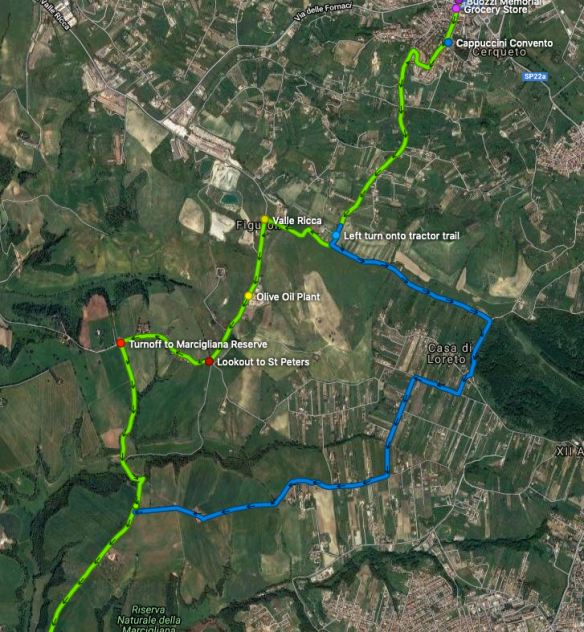Update: Our thanks to local volunteers who’ve found a much easier alternate. As you approach the gate after the olive oil factory, checked to see if it is locked. If it’s locked, turn off onto a path on the right that allows you to bypass the gate. This alternative has been cleared with the neighbors and property owners, so you’re free to use it with a clear conscience.
The following alternative is retained here in case there is any problem with the work-around above.
I’m sad to report that Way of St Francis neighbors in the Valle Ricca and Tor San Giovanni neighborhoods have locked the gate to the private road on their property, making access to Monte Sacro and Rome much more difficult for pilgrims leaving Monterotondo (Stage 26, Way of St Francis). The gate is locked just after the olive oil plant. A big thanks to Gigi Bettin and volunteers in the Lazio region for finding a temporary alternative that adds only 1.7km to the day’s walk.
The GPX tracks for this alternate can be downloaded from Wikiloc at this link.
Here are directions:
At the end of Via Sant’Angelo (guidebook p. 249) turn left as directed and begin walking along the field with a house and tall, bamboo hedge on your right. Instead of turning right as directed in the book, turn left and (thanks to the kindness of the property owner) follow the edge of the crops, soon coming alongside a ditch. A two-track farm road soon picks up and then becomes a gravel road that ends abruptly at a wood, the Trentani Park. Turn right and continue uphill. Follow this 500m to the first right and in a few meters cross the Via Cesa di Loreto and go straight in a neighborhood of small olive groves and farms. Take the first right (on the paved Via Selva Dei Cavalleri) and then the second left (onto the Via di Quatro Conca). Turn right before the gate of the Villa Sesterzi and follow this road past the back side of the La Cerquetta agriturismo. Continue on past the end of the pavement and cross the wide field on a faint track, aiming at the farmhouse and outbuildings. You are now in the Marcigliana Preserve. Pick up the farm’s driveway, continuing west, until it ends. Turn left and find yourself on the original track.
This is what it looks like from the satellite:

The original track after Monterotondo is in green; the temporary alternate is in blue.
Guidebook updates will be loaded when a permanent alternative track has been set. Thanks for your patience! -SB











